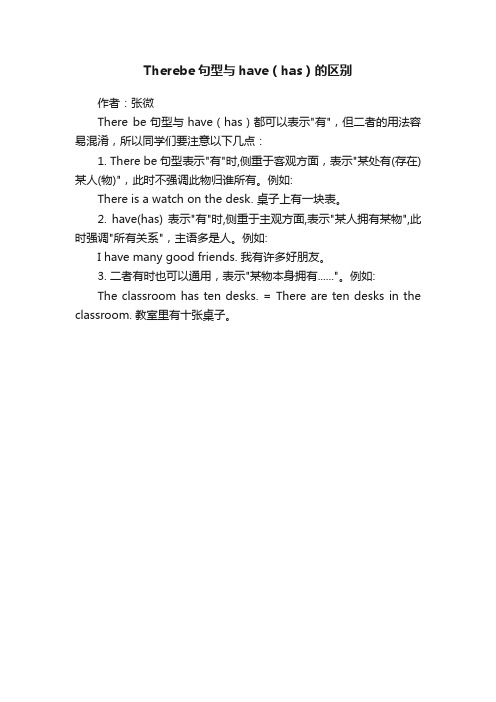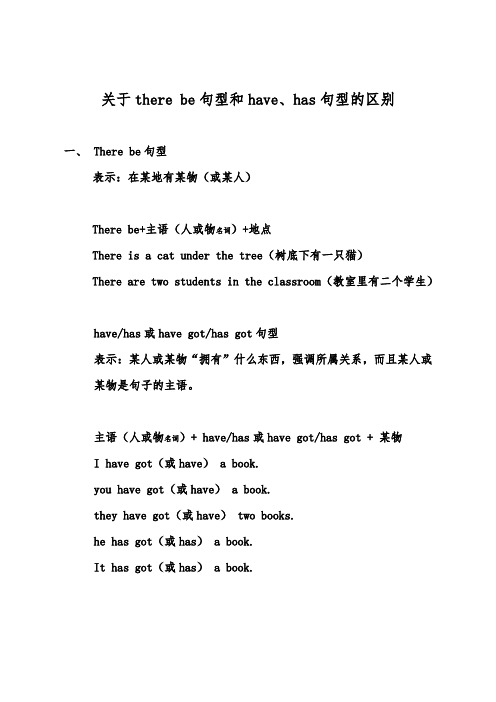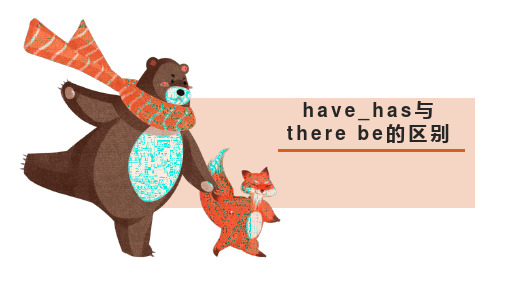therebe与havehas用法区别
最新版-微课课件 have_has 与 there be 区别

2.二者在句中位置不同:
• have \has在主语之后, there be 在句首 e.g.
1. I have a happy family. 2. He has a big house. 3. They have two children. 4. There is a big tree in front of our classroom. 5. There are many beautiful flowers in our school.
desk. 6)墙上有一张地图。 There is a map on the wall.
Practicing(二)
• .用have\has 或there be 填空
• 1. We
a big family.
• 2. My brother two good friends.
• 3. The Whites
have \has 与 there be 区别;
1. 含义不同:have \has表示“拥有” 其后的宾语属于主语拥有,别人是拿不走的。
例如:
I have a happy family. 我有一个幸福的家庭。 He has a big house. 他有一所大房子。 They have two children. 他们有两个孩子。
there be 表示某处存在某物,表示存在的“有”, 某物如果从这个地方移走就不存在了。
• There is a big tree in front of our classroom.
• 我们教室的前面有一颗大树。
There are many beautiful flowers in our school.
Therebe句型与have(has)的区别

Therebe句型与have(has)的区别
作者:张微
There be句型与have(has)都可以表示"有",但二者的用法容易混淆,所以同学们要注意以下几点:
1. There be句型表示"有"时,侧重于客观方面,表示"某处有(存在)某人(物)",此时不强调此物归谁所有。
例如:
There is a watch on the desk. 桌子上有一块表。
2. have(has) 表示"有"时,侧重于主观方面,表示"某人拥有某物",此时强调"所有关系",主语多是人。
例如:
I have many good friends. 我有许多好朋友。
3. 二者有时也可以通用,表示"某物本身拥有......"。
例如:
The classroom has ten desks. = There are ten desks in the classroom. 教室里有十张桌子。
关于there be句型和have及has的区别

关于there be句型和have、has句型的区别一、There be句型表示:在某地有某物(或某人)There be+主语(人或物名词)+地点There is a cat under the tree(树底下有一只猫)There are two students in the classroom(教室里有二个学生)have/has或have got/has got句型表示:某人或某物“拥有”什么东西,强调所属关系,而且某人或某物是句子的主语。
主语(人或物名词)+ have/has或have got/has got + 某物I have got(或have) a book.you have got(或have) a book.they have got(或have) two books.he has got(或has) a book.It has got(或has) a book.二、There be句型的结构There is +单数可数名词(或不可数名词)There is a book on the desk.There is some water in the bottle.(瓶子里有一些水)There are +复数名词There are some pictures on the wall.(墙上有一些图画)There are two apples in the basket.(篮子里有二个苹果)在There be句型中,单数用is,复数用are,不可数的通通用is 就近原则:最接近动词be的那个词是复数就用are,是单数或不可数的就用is。
There is a girl and two boys under the tree.There are two boys and a girl under the tree.三、There be句型的否定句及一般疑问句否定句:在动词be后面加not如果见到not/n’t,则要把句子中的some变成any。
英语中的“有”Have、has和there be 的用法区别详解

英语中的“有”Have、has和there be 的用法区别详解Have、has和there be 的用法区别详解Have和there be 都表示“有”的意思,但它们的用法不一样。
现举例来说明一下1、have 和has表示“某人有”或者“某物有”,它的主语在它的前面。
如:I have a friend.我有一个朋友。
某人有,主语I 在have 的前面。
The house has two windows.这个房子有两个窗户。
某物有,主语house在has的前面。
2、there be表示“有某人”或“有某物”,它的主语在动词be的后面。
如:There is a house over there. 那边有一座房子。
本句中, a house才是句子的主语。
也就是说,如果在汉语中,句子没有主语,那就要用there be 结构,而不用have或has.如:(1)教室里有两个男孩。
本句没有主语,因为“教室”可以做主语,但“教室里”不能做主语,在英语中,“教室里”是一个介词短语in the classroom,介词短语是不能做主语的,因此这句话应该表达为:There are two boys in the classroom.(2)墙上有一幅画。
和上句一样,“墙”可以用作主语,但“墙上”不能用作主语,它是介词短语on the wall,句子应当表达为:There is a picture on the wall.(3)有一些学生在操场上。
这个汉语句子就明显没有主语,而是以“有”开头,这样的句子想都不用想就there be 结构,即:There are some students on the playground.注意:“Between the two trees stands a boy.”这句话也并不是用介词短语between the two trees 做主语,而是倒装句,它的主语是后面的a boy,正常的语序是:A boy stands between the two trees.3、have 的第三人称单数形式是has,但如果在疑问句或否定句中有助动词does或doesn’t时,仍然要用have.如:(1)He has a pen.(他有一支钢笔)(2)Does he have a pen?(他有一支钢笔吗?有助动词Does)(3)He doesn’t have a pen. (他没有钢笔,有助动词doesn’t)4、There be中动词be要根据后面的第一个主语的单复数变化而变化。
have_has与there be的区别 课件

He has a pen. She has a ruler. It has a short tail. Jim has a pencil .
have与has的区别
I You We have ... They 复数
She he It 单数
has...
连线
连线 Emma·
My parents· Your sister ·
Henry Ella Henry and Ella don’t have two pencils.
there be的否定形式
There be 的否定:没有
There is a school bag in the table. There is not a school bag in the table.
观察句子,总结规律
I have a cat.
I don’t have a cat.
You have a fish.
You don’t have a fish.
We have flowers.
We don’t have flowers.
They have books.
They don’t have books.
There be 与 have/has的区别
1.There be 表示某个地方有什么 There is a cat in the box
2.have/has 表示人有什么 I have a school bag.
have和has怎么使用
观察句子,总结规律
I have a cat. You have a fish. We have flowers. They have books. Jim and Jenny have toys.
初中英语there be句型和have、has的介绍及区别精品课件

二、there be 句型的常考点 考点一:各种句型转化
1、变成否定句
There be句型的否定式的构成和含有be动词的其它 句型一样,在be动词后加上not即可。
2、变成一般疑问句
There be句型的一般疑问句变化是把be动词调整 到句首,再在句尾加上问号即可。当肯定句中有 some时,要将其改为any(否定变化也一样)。
在儿时的记忆中,父亲是很严厉的。他 对我的 要求非 常严格 ,用他 自己的 话说就 是:“ 女孩子 从小就 要受规 矩。” 他像培 养一个 大家闺 秀般地 培养我 ,我说 话、走 路、坐 卧、吃 饭乃至 端碗的 姿势都 必须按 他的要 求去做 。小时 候,他 经常把 我关在 家里, 让我背 《三字 经》、 《增广 贤文》 、《弟 子规》 、《千 字文》 等古文 。而只 比我大 一岁的 哥哥, 父亲却 放任他 在外面 自由自 在地玩 耍。于 是,这 样一幅 画面便 在我脑 子里永 久定格 :父亲 拿着一 把尺子 ,我像 个受戒 的小和 尚一样 恭恭敬 敬站在 他面前 ,一字 一句地 背:“ 人之初 ,性本 善。性 相近, 习相远 ……” 背不出 来,父 亲手里 的尺子 就高高 扬起, 而此时 哥哥正 躲在一 旁幸灾 乐祸地 偷笑。 经常是 我一边 背、一 边哭。 那时的 我心里 想的就 是:我 怎么命 这么苦 啊?有 个地主 爸爸, 让我受 这么多 的臭规 矩。如 果我有 个贫农 爸爸, 保证我 再不会 背什么 “养不 教,父 之过。 教不严 ,师之 惰”了 。
表兄很是着急,把家族里学历比较高的 我也搬 了出来 ,希望 我能劝 劝小立 。
“我虽然这些年到处打工也挣了一些钱 ,但这 样挣钱 太辛苦 了,我 不希望 他重走 我的老 路,” 堂兄苦 口婆心 ,一再 强调, “你一 定要好 好劝劝 他:不 上学以 后没有 出路。 ”
there be与have,has用法练习 (优选.)
wo最新文件---------------- 仅供参考--------------------已改成-----------word文本--------------------- 方便更改rdThere be 句型与have, hasThere be 句型与have, has的区别1、There be 句型表示:在某地有某物(或人)2、在there be 句型中,主语是单数,be 动词用is ; 主语是复数,be 动词用are ; 如有几件物品,be 动词根据最*近be 动词的那个名词决定。
3、there be 句型的否定句在be 动词后加not , 一般疑问句把be 动词调到句首。
4、there be句型与have(has) 的区别:there be 表示在某地有某物(或人);have(has) 表示某人拥有某物。
5、some 和any 在there be 句型中的运用:some 用于肯定句,any 用于否定句或疑问句。
6、and 和or 在there be句型中的运用:and 用于肯定句,or 用于否定句或疑问句。
7、针对数量提问的特殊疑问句的基本结构是:How many + 名词复数+ are there + 介词短语?How much + 不可数名词+ is there + 介词短语?8、针对主语提问的特殊疑问句的基本结构是:What’s + 介词短语?Ⅰ语法填空1.there be 句型表示:2.在there be 句型中,主语是单数,be动词用;主语是复数,be动词用;如有几件物品,be动词根据最靠近be动词的那个名词决定。
3.There be句型的否定句在be动词后面加,一般疑问句把be动词调到。
4.There be句型与have(has)的区别:there be句型表示;have(has)表示。
5.some和any在there be句型中的运用:some用于句;any用于句6.How many开头的特殊疑问句的基本结构是:How many+名词++ ?7.写出下列表示方位的介词:1)在……附近2)在……里面3)在……上面4)在……下面5)在……前面6)在……后面7)在……旁边Ⅱ用适当的be动词填空1.There a photo in my purse.2.There two boys in the bus.3. there a map on the wall?4.There two rulers and a pen over there.5.There a dog,a cat and five horses on the hill.6.There no money in my purse.7.There no books in the bag.8.There not any books in the bag.9.There no book in the bag. 10.There not a book in the bag.Ⅲ用any和some填空1.There are flowers under the tree.2.Are there birds in the picture?3.There aren’t cars behind the house.4.Are there books in the bag?No,there aren’t .Ⅳ用there is, there are, have, has填空1. a cup on my table.2.I a new sharpener.3. six birds in the tree.4.My uncle a good friend.5. a pencil, a ruler and two books on the teacher’s desk.Ⅴ句型转换1.There is a dog under the tree(变否定句)2.There is a map of Macao on the wall(变一般疑问句)3.There are some apples on the tree(变否定句)4.There are some chairs in Nick’s room(变一般疑问句)5.There is a dog under the tree.(划线部分提问)6.There are eleven computers in the big room.(划线提问)7.Is there a child in the car? (写出肯定和否定回答)8.Are there any balls behind the door?(写出肯定和否定回答)9.How many trees are there near the river? (写出三种不同的回答) Ⅵ汉译英1.有一只猫在椅子下。
there be和have的区别
there be句型表达的是“在某个地方存在某人、某物等”,have/has则表示“某人拥有某物”。
当主语为第三人称单数时,使用has;其他人称作主语,则使用have。
在there be句型中,主语是单数,be动词用is;主语是复数,be动词用are。
there be造句
There is a book on the desk.
课桌上有一本书.
How many people are there in the city?
这个城市里有多少人口.
There is a pen and two books on the desk.
课桌上有一个钢笔和两本书.
There are two books and a pen on the desk.
课桌上有两本书和一个钢笔.
There are some students and a teacher in the classroom.
在教室里有一些学生和一位老师.
have造句
I have a new pen.
我有了一支新的钢笔。
That have a lot of money.
他们有很多钱。
Have some apples.
来点苹果吧。
I have already finished my homework.
我已经完成我的作业了。
I have fish for dinner. 晚餐我有鱼吃。
therebe与havehas用法区别
therebe与havehas用法区别there be与have/has用法区别there be与have/has用法区别1.there be结构主要表示“某地(某时)有……”表there be与have/has 用法区别1.there be结构主要表示“某地(某时)有……”表示事物的存在,它不能表示“所有;拥有”,即“某人(物)有……”。
There be中的动词be(is, are)是“存在”的意思。
there在这种句型中是引导词,没有实际词义。
由there引导的这种结构,主语应放在动词be(is,are)之后,与其在数方面保持一致。
其结构如下:“there be+名词(主语)+地点状语或时间状语。
"例如: (1)There are many students in the classroom。
教室里有许多学生。
(2)There is a picture on the wall. 墙上有张画。
(3)There are seven days in a week。
一周有七天。
(4) There is a box of apples on the table。
在there be 结构中一定要注意谓语就近的原则.(5)There is a pen and two books on the desk.(6)There are two books and a pen on the desk。
2.动词have/has表示“有”时,它通常有三个含义:A.表示“某人(在物质上的)所有。
”这种情况下不能用there be替换.如: I have a new watch。
我有一块新表。
He has a good friend。
他有一个好朋友。
B.表示“某人或动物(在身体上的)长有”.这种情况也不能用there be替换。
如: She has blue eyes. 她的眼睛是蓝色的。
A horse has two ears. 马有两只耳朵.C.表示“某物体(在结构上的)装有”。
六年级语法知识点:Have、Has和There be结构.doc
2018长沙六年级语法知识点:Have、Has和There be
结构
Have、Has和There be结构
1、There be结构包括there is there are there was there were
2、意思都是“有”。
3、和have、has、had的区别:
(1)There be 句型表示:在某地有某物(或人)
(2)在there be 句型中,主语是单数,be 动词用is ; 主语是复数,be 动词用are ; 如有几件物品,be 动词根据最近be 动词的那个名词决定。
(3)there be 句型的否定句在be 动词后加not , 一般疑问句把be 动词调到句首。
(4)there be句型与have(has) 的区别:there be 表示在某地有某物(或人);have(has) 表示某人拥有某物。
(5)some 和any 在there be 句型中的运用:some 用于肯定句,any 用于否定句或疑问句。
(6)and 和or 在there be句型中的运用:and 用于肯定句,or 用于否定句或疑问句。
(7)针对数量提问的特殊疑问句的基本结构是: How many + 名词复数+ are there + 介词短语? How much + 不可数名词+ is there + 介词短语?
(8)针对主语提问的特殊疑问句的基本结构是: What’s + 介词短
语?
(9)There be结构一般用在句子的开头,而have等词只能用于某一个主语后面。
- 1、下载文档前请自行甄别文档内容的完整性,平台不提供额外的编辑、内容补充、找答案等附加服务。
- 2、"仅部分预览"的文档,不可在线预览部分如存在完整性等问题,可反馈申请退款(可完整预览的文档不适用该条件!)。
- 3、如文档侵犯您的权益,请联系客服反馈,我们会尽快为您处理(人工客服工作时间:9:00-18:30)。
therebe与havehas用法区别
there be与have/has用法区别
there be与have/has用法区别
1.there be结构主要表示“某地(某时)有……”表there be 与have/has用法区别
1.there be结构主要表示“某地(某时)有……”表示事物的存在,它不能表示“所有;拥有”,即“某人(物)有……”。
There be中的动词be(is, are)是“存在”的意思。
there在这种句型中是引导词,没有实际词义。
由there引导的这种结构,主语应放在动词be(is,are)之后,与其在数方面保持一致。
其结构如下:“there be+名词(主语)+地点状语或时间状语。
”例如:(1)There are many students in the classroom. 教室里有许多学生。
(2)There is a picture on the wall. 墙上有张画。
(3)There are seven days in a week. 一周有七天。
(4) There is a box of apples on the table.
在there be 结构中一定要注意谓语就近的原则。
(5)There is a pen and two books on the desk.
(6)There are two books and a pen on the desk.
2.动词have/has表示“有”时,它通常有三个含义:A.表示“某人(在物质上的)所有。
”这种情况下不能用there
be替换。
如:I have a new watch. 我有一块新表。
He has a good friend. 他有一个好朋友。
B.表示“某人或动物(在身体上的)长有”。
这种情况也不能用there be替换。
如:She has blue eyes. 她的眼睛是蓝色的。
A horse has two ears. 马有两只耳朵。
C.表示“某物体(在结构上的)装有”。
这种情况可以用there be替换。
如:
A clock has a round face.= There is a round face on a clock. 钟上装有一个圆型的钟盘。
That room has only two windows.= There are two windows in that room.
那个房间仅装有两扇窗户。
The school has 14 classes. = There are 14 classes in the school.那个学校有14个班级。
D.另外,表示“某人手中有某物”时,也用have/has.例如:Mary has a glass of water in her hand. 玛丽手中端着一玻璃杯示事物的存在,它不能表示“所有;拥有”,即“某人(物)有……”。
There be中的动词be(is, are)是“存在”的意思。
there在这种句型中是引导词,没有实际词义。
由there 引导的这种结构,主语应放在动词be(is,are)之后,与其在数方面保持一致。
其结构如下:
“there be+名词(主语)+地点状语或时间状语。
”例如:(1)There are many students in the classroom. 教室里有许多学生。
(2)There is a picture on the wall. 墙上有张画。
(3)There are seven days in a week. 一周有七天。
(4) There is a box of apples on the table.
在there be 结构中一定要注意谓语就近的原则。
(5)There is a pen and two books on the desk.
(6)There are two books and a pen on the desk.
2.动词have/has表示“有”时,它通常有三个含义:A.表示“某人(在物质上的)所有。
”这种情况下不能用there be替换。
如:I have a new watch. 我有一块新表。
He has a good friend. 他有一个好朋友。
B.表示“某人或动物(在身体上的)长有”。
这种情况也不能用there be替换。
如:She has blue eyes. 她的眼睛是蓝色的。
A horse has two ears. 马有两只耳朵。
C.表示“某物体(在结构上的)装有”。
这种情况可以用there be替换。
如:A clock has a round face.= There is a round face on a clock. 钟上装有一个圆型的钟盘。
That room has only two windows.= There are two windows in that room. 那个房间仅装有两扇窗户。
The school has 14 classes. = There are 14 classes in the school.那个学校有14个班级。
D.另外,表示“某人手中有某物”时,也用have/has.例如:Mary has a glass of water in her hand. 玛丽手中端着一玻璃杯
(注:文档可能无法思考全面,请浏览后下载,供参考。
可复制、编制,期待
你的好评与关注)。
